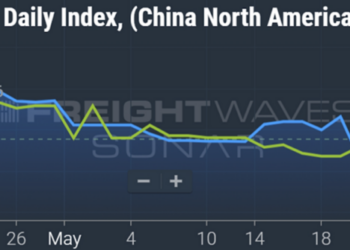FreightWaves’ State of Freight webinar for July offered a wide ranging discussion on everything from trucking bankruptcies, a surge in West Coast imports, to what a second Trump presidency could mean for the supply chain.
Craig Fuller, FreightWaves CEO and founder, said, “For many people, the presidential race is in many Americans’ minds, looking more and more like Donald Trump. And if you’re running a supply chain, you’re already thinking about what a Trump economy looks like.”
Here are five takeaways from the webinar:
Logistics operators should be considering how a 2nd Trump presidency could affect supply chains
If former president Donald Trump wins in November, his second term in office could mean tax cuts, increased import tariffs and accelerated depreciation for companies, Fuller said.
“There were a lot of people waiting to see what happened in November, because we largely believed it was gonna be a tight, contested race. It no longer appears that way,” Fuller said.
Fuller said having clarity on who will be the next U.S. president could create a surge in imports.
“I think we’ll see a lot more optimism just because there’s clarity. Whether you love a Donald Trump presidency or absolutely hate it, businesses want clarity. Consumers want clarity,” Fuller said. “We know that Donald Trump likes substantial tax cuts, which is going to create a lot of optimism. He loves things like accelerated depreciation. He’s never met a tariff that he doesn’t like. This is probably an economy that is going to be stimulated. I think that’s going to create some optimism where some of the economy looks tired. … I think there will be a level of confidence just because there’s more certainty of what a Donald Trump presidency looks like, versus a Biden presidency that stays the course. And that tends to be more favorable to freight.”
U.S. container imports are surging in June and July
Container import volume into the U.S. increased 14% year over year in June and as of July 18 is up 18% compared to the same period in July 2023, according to FreightWaves’ SONAR Inbound Ocean TEUs Volume Index (IOTI.USA)
“We have to talk about the import data, because the imports are on fire. This is near record levels,” Fuller said.
According to FreightWaves’ Inbound Ocean TEUs Volume Index for the U.S. (IOTI.USA), container shipments have been surging over the past two months. Chart: FreightWaves SONAR. To learn more, click here.
“The IOTI is an index that measures twenty-foot equivalent unit containers based on their estimated time of departure from the port of ladings. This is stuff that has yet to come into the United States and it is going bonkers,” Strickland said.
The import data is showing that a lot of freight has begun flowing into the U.S., which is a good sign for the freight economy, Fuller said.
“When you look at what is being loaded currently in China or around the world, we’re seeing some near record levels in terms of volume. It’s pretty profound,” Fuller said. “What’s great about this is it tells us a lot about what truckers can expect in the second half of the year.”
More capacity will be leaving the market in 2024
FreightWaves’ John Paul Hampstead recently wrote an article, “SBA disaster loans propped up carriers, prolonged Great Freight Recession,” which analyzed how $37 billion went to 419,500 companies in transportation and warehousing.
“We wanted to know about transportation companies, specifically trucking, warehousing and brokerages — how many of those companies actually took out loans, and the numbers were off the charts, $37 billion, nearly 10%, of the entirety of those loans went to trucking companies,” Fuller said.
Hampstead said that thousands of trucking companies that received COVID-19 Economic Injury Disaster Loans (EIDL) from the Small Business Administration (SBA) were able to have carriers hang around the market for far longer than anyone anticipated, keeping rates lower for longer.
“A full year after the market’s bottom in May 2023, rates had only increased by about a dime, to $1.60 per mile,” Hampstead wrote.
(The FreightWaves National Truckload Index – Linehaul measures the national average truckload spot rate exclusive of fuel in U.S. dollars per mile. Chart: SONAR. To learn more about SONAR, click here)
On average, trucking companies borrowed about $90,000 from the SBA’s EIDL program, according to Hampstead’s article.
“If you put that in perspective, an average owner-operator will generate take home pay of $65,000 to $70,000 a year. This potentially explains how all these small carriers have been able to hang out as long as they have and still lose money operating their trucks,” Fuller said. “This is the reason that the dynamics of this particular downturn have been operating like no other and how the small carriers survived. But it also tells us the reason we should be bullish is that the loans still exist; they have to pay it back. So we will see an accelerant of capacity leaving.”
A Trump election could boost the freight market
“Anytime we’ve seen a change in how the government regulates or stimulates the economy, it shows up in freight,” Fuller said. “These impacts are going to be felt. It’s going to change the availability of capacity, because it’s going to be harder to buy trucks and that’s going to be big.”
Fuller said he’s optimistic about the freight market for the rest of the year, as well as for 2025.
“If you’re looking into the last half, the second half of 2024, or the first half of 2025, you can’t help but be bullish on freight,” Fuller said.
Shippers should be looking to secure capacity before the market gets tight, Fuller said.
“The risk for the supply chains is definitely on the side of a capacity crunch,” Fuller said. “It is absolutely something that if you’re running a supply chain, you better be thinking about it. If you don’t, you’re going to run the risk of not having trucks.”
US-Mexico trade, border infrastructure continues to expand
“You have to be bullish on Mexico, the big winner over a lot of this is Mexico,” Fuller said. “I don’t think the Trump administration could completely cut off trade with Mexico and implement tariffs.”
Strickland said although Mexico still has some challenges to deal with, infrastructure along the border areas continue to improve.
“There’s infrastructure being built right along the border and that’s where the majority of the growth is occurring,” Strickland said. “We actually had a webinar this week, where we showed the growth of cross-border ports, Port Laredo, Texas, which is already expanding. It’s pulsating out more and more in places like El Paso, another one is Nogales, Arizona. All of them are showing growth.”
The post State of Freight for July: ‘Bullish’ market coming for freight economy appeared first on FreightWaves.













